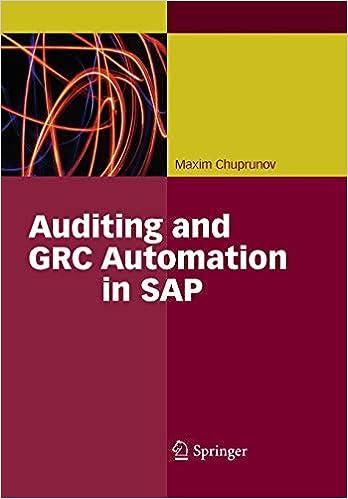Question
Prepare journal entries, income statement, statement of retained earnings and analysis for the following: One Trick Pony (OTP) incorporated and began operations near the end
Prepare journal entries, income statement, statement of retained earnings and analysis for the following:
| One Trick Pony (OTP) incorporated and began operations near the end of the year, resulting in the following post-closing balances at December 31: |
| Cash | $ | 18,620 |
| Accounts Receivable | 9,650 | |
| Allowance for Doubtful Accounts | 900* | |
| Inventory | 2,800 | |
| Unearned Revenue (30 units) | 4,350 | |
| Accounts Payable | 1,300 | |
| Notes Payable (long-term) | 15,000 | |
| Common Stock | 5,000 | |
| Retained Earnings | 4,520 | |
| * credit balance. | ||
| The following information is relevant to the first month of operations in the following year: |
| OTP will sell inventory at $145 per unit. OTPs January 1 inventory balance consists of 35 units at a total cost of $2,800. OTPs policy is to use the FIFO method, recorded using a perpetual inventory system. | |
| In December, OTP received a $4,350 payment for 30 units to be delivered in January; this obligation was recorded in Unearned Revenue. Rent of $1,300 was unpaid and recorded in Accounts Payable at December 31. | |
| OTPs note payable matures in three years, and accrues interest at a 10% annual rate. |
| January Transactions | |
| 1. | Included in OTPs January 1 Accounts Receivable balance is a $1,500 balance due from Jeff Letrotski. Jeff is having cash flow problems and cannot pay the $1,500 balance at this time. On 01/01, OTP arranges with Jeff to convert the $1,500 balance to a 6-month note, at 12% annual interest. Jeff signs the promissory note, which indicates the principal and all interest will be due and payable to OTP on July 1 of this year. |
| 2. | OTP paid a $500 insurance premium on 01/02, covering the month of January; the payment is recorded directly as an expense. |
| 3. | OTP purchased an additional 150 units of inventory from a supplier on account on 01/05 at a total cost of $9,000, with terms 2/15, n/30. |
| 4. | OTP paid a courier $300 cash on 01/05 for same-day delivery of the 150 units of inventory. |
| 5. | The 30 units that OTPs customer paid for in advance in December are delivered to the customer on 01/06. |
| 6. | On 01/07, OTP paid the amount necessary to settle the balance owed to the supplier for the 1/05 purchase of inventory (in 3). |
| 7. | Sales of 40 units of inventory occuring during the period of 01/07 01/10 are recorded on 01/10. The sales terms are 2/10, n/30. |
| 8. | Collected payments on 01/14 from sales to customers recorded on 01/10. The discount was properly taken by customers on $5,800 of these credit sales; consequently, OTP received less than $5,800. |
| 9. | OTP paid the first 2 weeks wages to the employees on 01/16. The total paid is $2,200. |
| 10. | Wrote off a $1,000 customers account balance on 01/18. OTP uses the allowance method, not the direct write-off method. |
| 11. | Paid $2,600 on 01/19 for December and January rent. See the earlier bullets regarding the December portion. The January portion will expire soon, so it is charged directly to expense. |
| 12. | OTP recovered $400 cash on 01/26 from the customer whose account had previously been written off on 01/18. |
| 13. | An unrecorded $400 utility bill for January arrived on 01/27. It is due on 02/15 and will be paid then. |
| 14. | Sales of 65 units of inventory during the period of 01/10 01/28, with terms 2/10, n/30, are recorded on 01/28. |
| 15. | Of the sales recorded on 1/28, 15 units are returned to OTP on 01/30. The inventory is not damaged and can be resold. |
| 16. | On 01/31, OTP records the $2,200 employee salary that is owed but will be paid February 1. |
| 17. | OTP uses the aging method to estimate and adjust for uncollectible accounts on 01/31. All of OTPs accounts receivable fall into a single aging category, for which 8% is estimated to be uncollectible. (Update the balances of both relevant accounts prior to determining the appropriate adjustment, and round your calculation to the nearest dollar.) |
| 18. | Accrue interest for January on the note payable on 01/31. |
| 19. | Accrue interest for January on Jeff Letrotskis note on 01/31 (see 1). |
For Analysis
| |||||||||||||||||||||||||||||||||||||||||||||||||||||
Step by Step Solution
There are 3 Steps involved in it
Step: 1

Get Instant Access to Expert-Tailored Solutions
See step-by-step solutions with expert insights and AI powered tools for academic success
Step: 2

Step: 3

Ace Your Homework with AI
Get the answers you need in no time with our AI-driven, step-by-step assistance
Get Started


